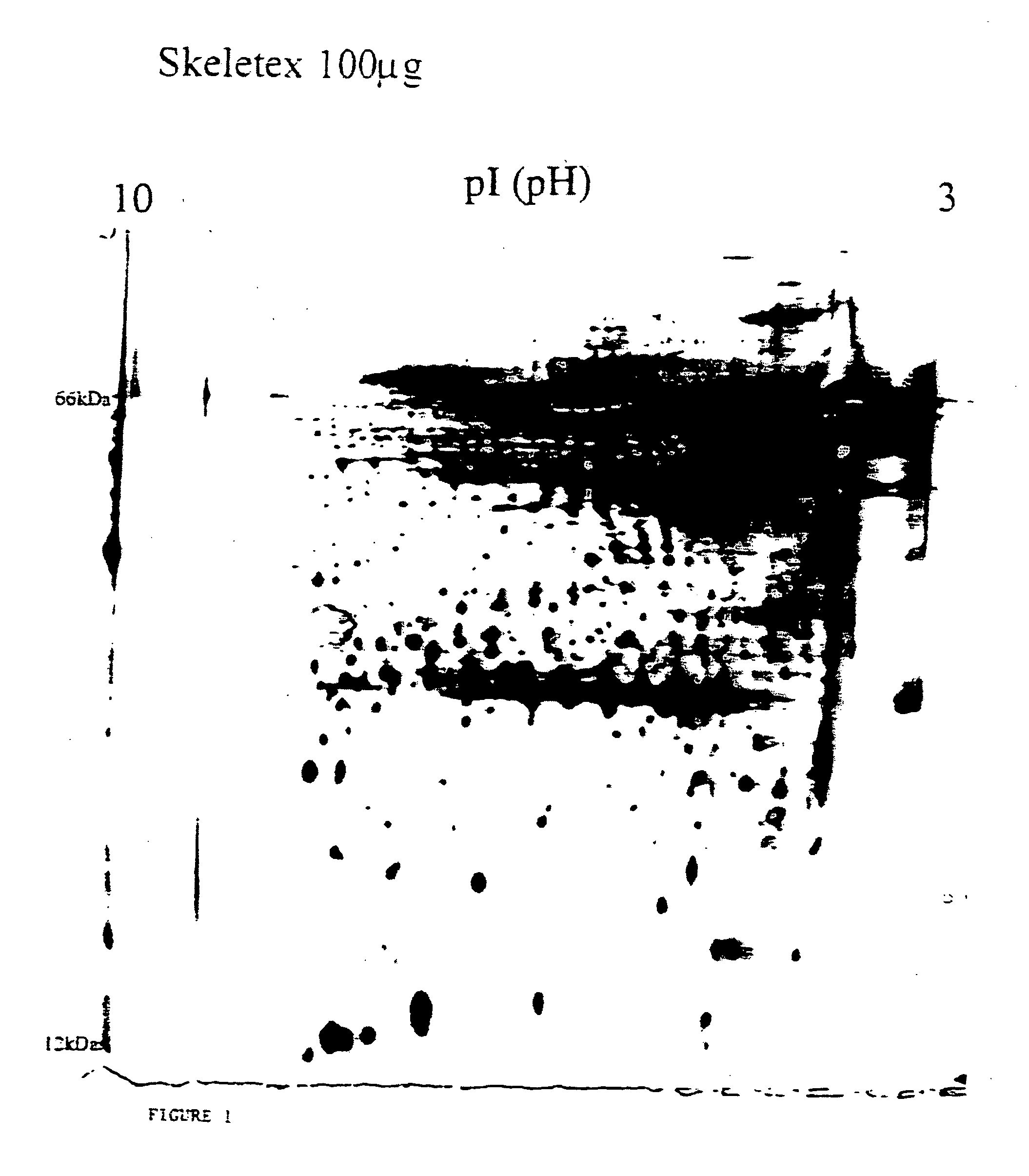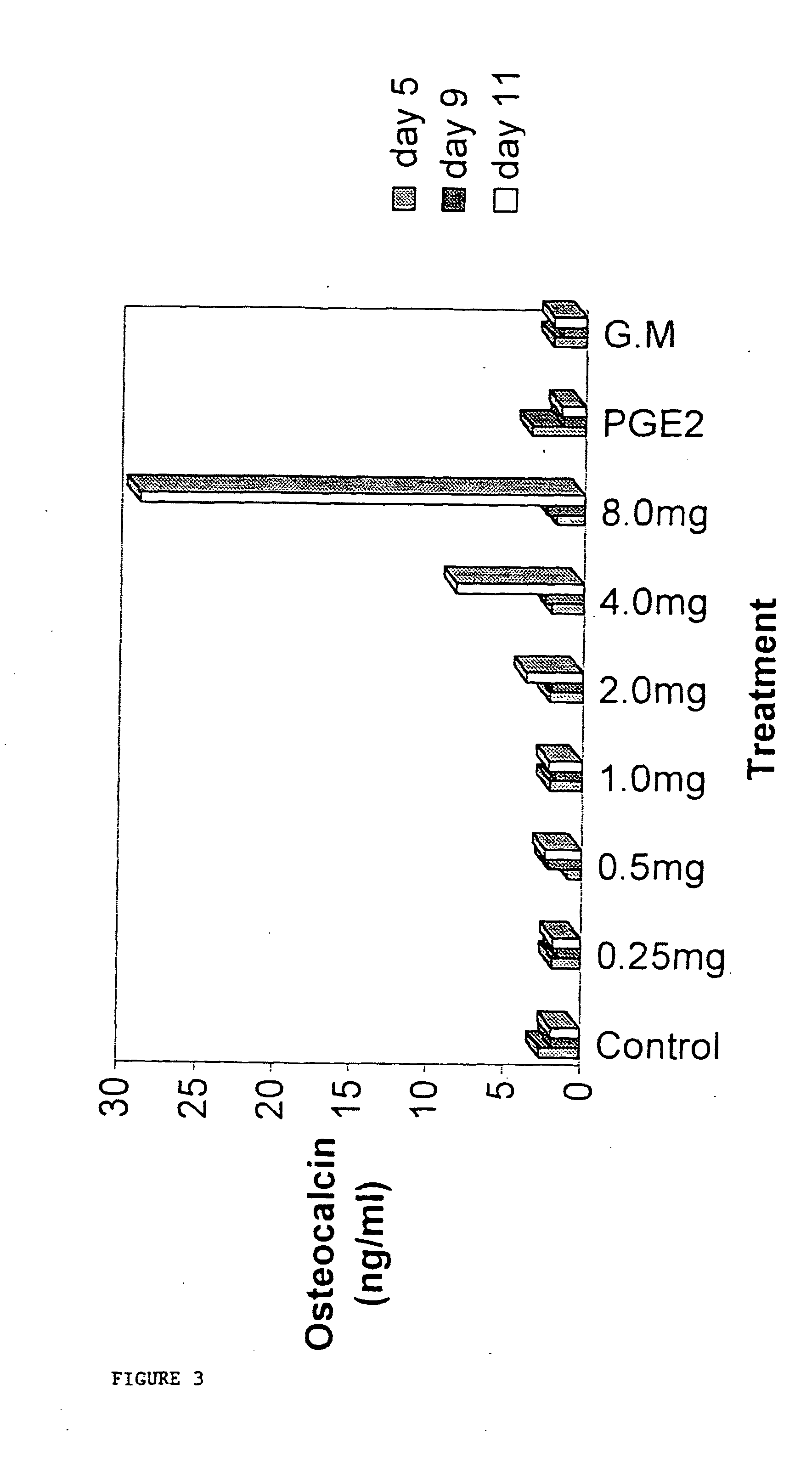Therapeutic biological product and method for formation of new vascularised bone
a technology of biological products and vascularised bones, applied in the direction of powder delivery, peptide/protein ingredients, peptide/protein ingredients, etc., can solve the problems of complex action, unfavorable surgical repair of lost bone, and limited success of igfs as local stimulators of bone healing, so as to achieve clear osseoinductive activity and achieve regulatory approval.
- Summary
- Abstract
- Description
- Claims
- Application Information
AI Technical Summary
Benefits of technology
Problems solved by technology
Method used
Image
Examples
example 1
An immortalised cell line identified as a human hypertrophic chondrocyte cell line was used as the example in this study (ref: WO 96 / 18728).
Experiment to Determine the In Vitro Osteoinductive Properties of Hypertrophic Chondrocytes on Rat Bone Marrow Cells, Using a CFU-f Assay.
Using the cell culture techniques described in the materials and methods sections above the following experiment was set up. To enable statistical analysis, each treatment group contained 3-4 petri dishes (10 cm diameter); but, where possible, 4 dishes were used to allow for validation of results if one dish became infected and thus void.
Control group. Bone Marrow Cells (Bmcs).
To 4 petri dishes, 10 ml of bone juice was added to 0.5 ml of rat BMC suspension (5×105 cells) and incubated at 37° C. and 5% CO2. No further additions were made and the medium was changed as specified in the method.
Treatment Group 1. Hypertrophic Chondrocytes—Mitomycin-C Treated Plus BMCs
3 petri dishes were seeded with 1.4×...
example 2
While grown in culture at either 33° C., and surprisingly at the permissive temperature of the active oncogene (37-39° C.), the immortalised human hypertrophic chondrocyte-like cells (HHC) expressed material which is released into the cell medium as, seemingly, cell debris or secreted extracellular matrix by the HHCs. The extracellular material produced is not restricted to a single clone but is a general characteristic of the skeletal cell lines that have been produced. A study was performed to see whether the material produced by these cells was capable of inducing the differentiation of marrow stromal cells into mineralising osteoblasts capable of elaborating a matrix, and secreting osteoblast marker proteins.
HHC cell “matrix” was collected as described in the materials and methods above and added to flasks containing bone marrow cells derived from rat femurs, or from human bone marrow biopsy material. In all cases the matrix—which was harvested from HHC medium, pelleted by ce...
example 3
Electrophoretic Analysis of the Bioactive Matrix Material Harvested from Immortalised Human Hypertrophic Cartilage Cells
In order to determine the components of the HHC harvested material polyacrylamide gel electrophoresis was performed, and one and two dimensional gel analysis used to isolate the proteins present. Examples of the 2-D gel analysis are provided in FIGS. 1 and 2.
The results demonstrate that the extracellular matrix harvested from the HHC cells comprises a complex mix of noncollagenous and collagenous matrix proteins some of which are glycosylated, and, in addition, numerous cytokines and growth factors. It shows clearly a very complex mix comprised of potentially hundreds of proteins of various sizes and mobilities.
As described in the introductory sections, the natural processes of endochondral and intramembranous ossification require a complex myriad of signalling, over a sustained period of time, to be completed. This is performed by numerous factors, many unk...
PUM
| Property | Measurement | Unit |
|---|---|---|
| composition | aaaaa | aaaaa |
| concentration | aaaaa | aaaaa |
| pH | aaaaa | aaaaa |
Abstract
Description
Claims
Application Information
 Login to View More
Login to View More - R&D
- Intellectual Property
- Life Sciences
- Materials
- Tech Scout
- Unparalleled Data Quality
- Higher Quality Content
- 60% Fewer Hallucinations
Browse by: Latest US Patents, China's latest patents, Technical Efficacy Thesaurus, Application Domain, Technology Topic, Popular Technical Reports.
© 2025 PatSnap. All rights reserved.Legal|Privacy policy|Modern Slavery Act Transparency Statement|Sitemap|About US| Contact US: help@patsnap.com



